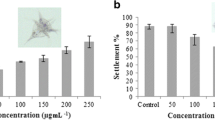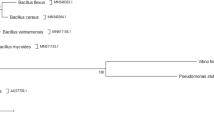Abstract
Marine organisms have usually been viewed as sources of environmentally friendly compounds with antifouling activity. We performed a series of operations to investigate the antifouling potential of the marine microalga Dunaliella salina. For the ethyl acetate crude extract, the antialgal activity was significant, and the EC50 value against Skeletonema costatum was 58.9 μg ml−1. The isolated purified extract was tested for antifouling activity, the EC 50 value against S. costatum was 21.2 μg ml−1, and the LC50 against Balanus amphitrite larvae was 18.8 μg ml−1. Subsequently, both UHR–TOF–MS and GC–MS were used for the structural elucidation of the compounds, and a series of unsaturated and saturated 16- and 18-carbon fatty acids were detected. The data suggested that the fatty acid extracts from D. salina possess high antifouling activity, and could be used as substitutes for potent, toxic antifouling compounds.






Similar content being viewed by others
References
Acevedo MS, Puentes C, Carreño K, León JG, Stupak M, García M, Pérez M, Blustein G (2013) Antifouling paints based on marine natural products from Colombian Caribbean. Int Biodeter Biodegr 83:97–104
Akhunov AA, Gusakova SD, Taubaev TT, Umarov AU (1978) Isolation and antibiotic properties of cis-4,7,10,13-hexadecatetraenoic acid from Scenedesmus obliquus UA-2-6 alga. Khim Prir Soedin 3:379–385
Alzieu C (2000) Impact of tributyltin on marine invertebrates. Ecotoxicology 9:71–76
Bazes A, Silkina A, Douzenel P, Fa F, Kervarec N, Morin D, Berge JP, Bourgougnon N (2009) Investigation of the antifouling constituents from the brown alga Sargassum muticum (Yendo) Fensholt. J Appl Phycol 10:1573–1576
Bhadury P, Wright PC (2004) Exploitation of marine algae: biogenic compounds for potential antifouling applications. Planta 219:561–578
Dafforn KA, Lewis JA, Johnston EL (2011) Antifouling strategies: history and regulation, ecological impacts and mitigation. Mar Pollut Bull 62:453–465
Desbois AP, Lebl T, Yan L, Smith VJ (2008) Isolation and structural characterisation of two antibacterial free fatty acids from the marine diatom, Phaeodactylum tricornutum. Appl Microbiol Biotechnol 81:755–764
El Gamal AA (2010) Biological importance of marine algae. Saudi Pharm J 18:1–25
Galbraith H, Miller TB (1973) Physiological effects of long chain fatty acids on bacterial cells and their protoplasts. J Appl Bacteriol 36:647–658
Guillard RRL (1975) Culture of phytoplankton for feeding marine invertebrates. Springer, New York, pp 29–60
Hellio C, Berge JP, Beaupoil C, Gal YL, Bourgougno N (2002) Screening of marine algal extracts for anti-settlement activities against microalgae and macroalgae. Biofouling 18:205–215
Hellio C, Maréchal JP, Da Gama BAP, Pereira R, Clare AS (2009) Natural marine products with antifouling activities. Advances in marine antifouling coatings and technologies. Woodshead, Cambridge, pp 572–622
Jesus SS, Filho RM (2010) Modeling growth of microalgae Dunaliella salina under different nutritional conditions. Am J Biochem 6:279–283
Kharchenko U, Beleneva I, Dmitrieva E (2012) Antifouling potential of a marine strain, Pseudomonas aeruginosa 1242, isolated from brass microfouling in Vietnam. Int Biodeterior Biodegrad 75:68–74
Kwong TF, Miao L, Li X, Qian PY (2006) Novel antifouling and antimicrobial compound from a marine-derived fungus Ampelomyces sp. Mar Biotechnol 8:634–640
Maréchal JP, Hellio C (2011) Antifouling activity against barnacle cypris larvae: do target species matter (Amphibalanus amphitrite versus Semibalanus balanoides)? Int Biodeterior Biodegrad 65:92–101
Miller RD, Brown KE, Morse SA (1977) Inhibitory action of fatty acids on the growth of Neisseria gonorrhoeae. Infect Immun 17:303–312
Ohta S, Chang T, Kawashima A, Nagate T, Murase M, Nakanishi H, Miyata H, Kondo M (1994) Anti methicillin-resistant Staphylococcus aureus (MRSA) activity by linolenic acid isolated from the marine microalga Chlorococcum HS-101. Bull Environ Contam Toxicol 52:673–680
Okumura Y, Koyama J, Takaku H, Satoh H (2001) Influence of organic solvents on the growth of marine microalgae. Arch Environ Contam Toxicol 41(2):123–128
Qi SH, Zhang S, Yang LH, Qian PY (2008) Antifouling and antibacterial compounds from the gorgonians Subergorgia suberosa and Scripearia gracillis. Nat Prod Res 22:154–166
Qian PY, Xu Y, Fusetani N (2010) Natural products as antifouling compounds: recent progress and future perspectives. Biofouling 26(2):223–234
Rittschof D, Lai CH, Kok LM, Teo SL (2003) Pharmaceuticals as antifoulants: concept and principles. Biofouling 19:207–212
Shimizu Y (1996) Microalgal metabolites: a new perspective. Ann Rev Microbiol 50:431–465
Silkina A, Bazes A, Mouget JL, Bourgougnon N (2012) Comparative efficiency of macroalgal extracts and booster biocides as antifouling agents to control growth of three diatom species. Mar Pollut Bull 64:2039–2046
Suggett DJ, Prášil O, Borowitzka MA (2011) Chlorophyll a fluorescence in aquatic sciences: methods and applications. In: Masojídek J (ed) Chlorophyll fluorescence applications in microalgal mass cultures. Developments in applied phycology. Springer, New York, pp 277–291
Thiyagarajan V, Harder T, Qian PY (2003) Combined effect of temperature and salinity on larval development and attachment of the subtidal barnacle Balanus trigonus Darwin. J Exp Mar Biol Ecol 287:223–236
Thomas KV, Brooks S (2010) The environmental fate and effects of antifouling paint biocides. Biofouling 26:73–88
Wahl M (1989) Marine epibiosis. I. Fouling and antifouling: some basic aspects. Mar Ecol Prog Ser 58:175–189
Wu JT, ChiangYR Huang WY, Jane WN (2006) Cytotoxic effects of free fatty acids on phytoplankton algae and cyanobacteria. Aquat Toxicol 80:338–345
Xu Y, Li HL, Li XC, Xiao X, Qian PY (2009) Inhibitory effects of a branched-chain fatty acid on larval settlement of the polychaete Hydroides elegans. Mar Biotechnol 11:495–504
Yebra DM, Kill S, Dam-Johansen K (2004) Antifouling technology: past, present and future steps towards efficient and environmentally friendly antifouling coatings. Prog Org Coat 50:75–104
Acknowledgments
This study was supported by the Natural Science Foundation of China (No. 41376106) and the Natural Science Foundation of Shandong province (ZR2013DM017).
Author information
Authors and Affiliations
Corresponding author
Rights and permissions
About this article
Cite this article
Gao, M., Li, F., Su, R. et al. Antifouling potential of the marine microalga Dunaliella salina . World J Microbiol Biotechnol 30, 2899–2905 (2014). https://doi.org/10.1007/s11274-014-1717-x
Received:
Accepted:
Published:
Issue Date:
DOI: https://doi.org/10.1007/s11274-014-1717-x




